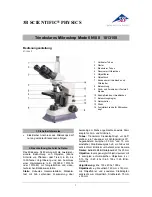
CHAPTER 2 - SAMPLE PREPARATION
Lightsheet Z.1
Specific Examples of Sample Preparation
Carl Zeiss
02/2013
000000-1790-528
29
8.
Suck in the agarose/beads by pulling the opposite end of the wire/plunger.
9.
Let the gel polymerize (approx. 5 minutes) before imaging.
10.
Make sure that only a very short part of the agarose block is pulled out of the glass capillary during
image acquisition.
11.
When multiple views are recorded, it is best to image from the centre of the agarose block.
Beads should be fluorescent in the part of the spectrum you would like to analyze for 1 channel
systems. With the Lightsheet Z.1, a two channel system, one can use one channel for the beads
(e.g., red) and one channel for the specimen label (e.g, GFP.) Fluorescent beads covering whole
visible spectrum are nowadays easily available from various different suppliers (e.g. Polysciences,
Invitrogen, Estapor / Merck etc.). In our case, the density of the fluorescent beads is chosen to end
up with several hundred beads in the imaged volume. For example, for a 40x magnification lens the
volume of interest is around (200 µm)
3
= 8*10
-6
ml.
If the fluorescent
beads are shipped as a solution of 5*10
13
particles/ml
, you have to dilute
them 1:10
6
in agarose to have approximately 400 particles in the volume of interest. Having
too few of them (less than 100) in the three-dimensional image will give you no or poor processing
results, while too many of them (more than 1000) might considerably increase processing time
without a significantly improving the final results.
Moreover, a gel with sufficient stiffness but minimal impact on the image has to be used to immobilize
the beads. 1 % low-melting agarose (Sigma, Type VII) is being routinely applied for lenses with numerical
apertures up to 0.8 NA. For 1.0 NA objective lenses and above, a more diluted (e.g. 0.5 %) gel must be
used to minimize gel-caused image aberration.
3.2
Preparation of a Medaka Fish Embryo (
Oryza latypes
)
Embryos have been extensively used for many decades to study developmental mechanisms as well as
diseases. They can range from micrometers to centimeters depending on the species used (frog, fish, fly,
worm, etc.). This protocol applies to most embryos. The important point is the temperature. The embryo
must not be damaged by temperature shock during embedding. Moreover, the embryo should not be
constraint by the stiffness of the gel. This may impair its normal development.
Equipment and reagents
−
1.5 % Low Melting Point (LMP) Agarose in E3 (Fish buffer)
−
Mesab/Tricaine 0.4 % stock (3-Aminobenzoic Acid Ethyl Ester)
−
Capillary (Size 4, Blue, #701910, BRAND GmbH)
−
Electrical thread (1,6 mm) or plunger
−
Heating block
Содержание Lightsheet Z.1
Страница 1: ...Lightsheet Z 1 Operating Manual February 2013 ZEN 2012 black edition ...
Страница 4: ......
Страница 170: ......
Страница 427: ...Lightsheet Z 1 Overview ...
















































